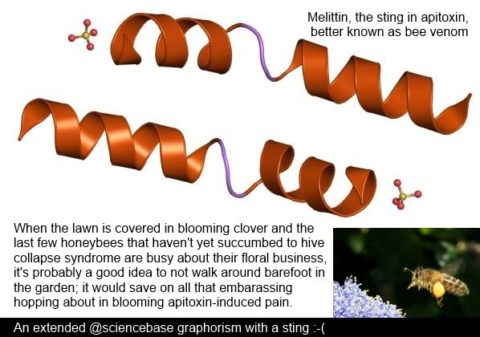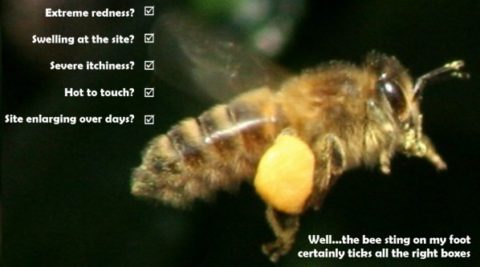When the garden lawn is covered in blooming clover (Trifolium) and the last few honeybees (Apis mellifera) that haven’t yet succumbed to colony collapse disorder are busy about their floral business, it’s probably a good idea to not walk around barefoot in the garden with one’s reading glasses on, it would help avoid all that embarrassing hopping about in blooming apitoxin-induced pain…caused mainly by melittin (Glycyl-L-isoleucylglycyl-L-alanyl-L-valyl-L-leucyl-L-lysyl-L-valyl-L-leucyl-L-threonyl-L-threonylglycyl-L-leucyl-L-prolyl-L-alanyl-L-leucyl-L-isoleucyl-L-seryl-L-tryptophyl-L-isoleucyl-L-lysyl-L-argin yl-L-lysyl-L-arginyl-L-glutaminyl-L-glutamamide)

UPDATE: Three days later. Sole of my foot is swollen, sore, red, hot to the touch and feels as if there’s a piece of tough leather just below the skin…nice…so headed to the Mayo Clinic website for their take on bee stings. Apparently, my sting is merely
moderate, I can barely put my shoe on, so yeah, moderate. A mild reaction would have subsided within a few hours. Conversely, a severe reaction might involve: skin reactions, including hives and itching and flushed or pale skin, difficulty breathing, swelling of the throat and tongue, a weak, rapid pulse, nausea, vomiting or diarrhoea, dizziness or fainting, loss of consciousness. Thankfully, Mayo says that a moderate reaction this time does
not predispose one to a severe allergic reaction on next apian encounter.

Honeybee photo by
David Bradley Photographer

